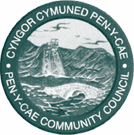Pen-y-cae, Wrexham
Pen-y-cae is a village and a local government community, the lowest tier of Welsh local government, part of Wrexham County Borough in Wales The population of the community taken at the 2011 census was 3,389.[1] It adjoins the larger village of Rhosllanerchrugog.
| Pen-y-cae | |
|---|---|
 Zion English Baptist Church, Pen-y-cae | |
 Pen-y-cae Location within Wrexham | |
| Population | 3,389 (2011) |
| OS grid reference | SJ279452 |
| Community |
|
| Principal area | |
| Country | Wales |
| Sovereign state | United Kingdom |
| Post town | WREXHAM |
| Postcode district | LL14 |
| Dialling code | 01978 |
| Police | North Wales |
| Fire | North Wales |
| Ambulance | Welsh |
| UK Parliament | |
| Senedd Cymru – Welsh Parliament | |

Etymology
Pen-y-cae means 'head of the field' or 'end of the field'. It is not an uncommon name, with three other settlements in Wales having the same name - in Powys, Bridgend and Neath Port Talbot. Though often written as one word without hyphens, in its correct form the name is hyphenised due to the definite article 'y' preceding a single-syllable element.[2]
History

The village was part of the ancient parish of Ruabon and the district was known as Dynhinlle Uchaf (but also known as Y Dref Fechan or Cristionydd Fechan).
The new parish of Pen-y-cae was formed 1879, from parts of the existing parishes of Ruabon, Rhosllanerchrugog and Rhosymedre. St. Thomas' Church, the then Parish Church, was consecrated in 1878. However, most of the population of the parish were nonconformists and attended the Baptist chapels of Salem and Sion in Groes; the Calvinistic Methodist chapels in Groes and Tainant; the Wesleyan chapel of Soar in Stryt Issa; or the Primitive Methodist chapel in Copperas.
Industry/employment

Coal was extracted from pits at Plas Bennion, Wynn Hall, Afon Eitha, Cristionydd, Groes and Plas Isaf; zinc was worked at Copperas. The area descending towards Acrefair was known as "The Delph", it was served by extensions of the Ruabon Brook Tramway but these were mostly defunct by the mid-20th century.
Most inhabitants find employment outside the village in Wrexham with only a few local shops or public buildings providing jobs.
Dee Valley Water operates two reservoirs in Pen-y-cae: Pen-y-cae Upper and Pen-y-cae Lower.
Transport
Wright & Son, ran a bus service from Pen-y-cae to Wrexham via Rhos, and later via Ponciau also. When the bus industry was de-regulated in 1986 there was fierce competition between Wright's and the much larger Crosville company. Wrights', the last surviving independent local company, ceased operations in 1993 leaving Crosville as the sole service provider in the Wrexham area.
Notable residents
- The Wales and Bolton Wanderers footballer, Robert Roberts, was born in Pen-y-cae in July 1864.[3]
References
- "Community population 2011". Retrieved 19 November 2015.
- Welsh Language Commissioner (20 May 2016). "Guidelines for Standardizing Place-names in Wales" (PDF). Welsh Language Commissioner. http://www.comisiynyddygymraeg.cymru/English/My%20rights/Pages/Place-names.aspx: Welsh Language Commissioner. p. 4. Retrieved 1 April 2018.CS1 maint: location (link)
- Davies, Gareth; Garland, Ian (1991). Who's Who of Welsh International Soccer Players. Bridge Books. p. 180. ISBN 1-872424-11-2.
Bibliography
- Dennis W Gilpin, "Rhosllannerchrugog, Johnstown, Ponciau, Pen-y-cae, a collection of pictures - Volume I" (1991)
- Dennis W Gilpin, "Rhosllannerchrugog, Johnstown, Ponciau, Pen-y-cae, a collection of pictures - Volume II" (1992)
- Colin Gibbs, "Clatter of Clogs" (1990)
External links
| Wikimedia Commons has media related to Penycae. |
- Pen-y-cae Community Council
- Pen-y-cae Football Club
- The Church of the Nazarene, Pen-y-cae
- St Thomas' Church, Pen-y-cae
- Photos of Pen-y-cae and surrounding area on Geograph
- Map sources for Pen-y-cae, Wrexham
